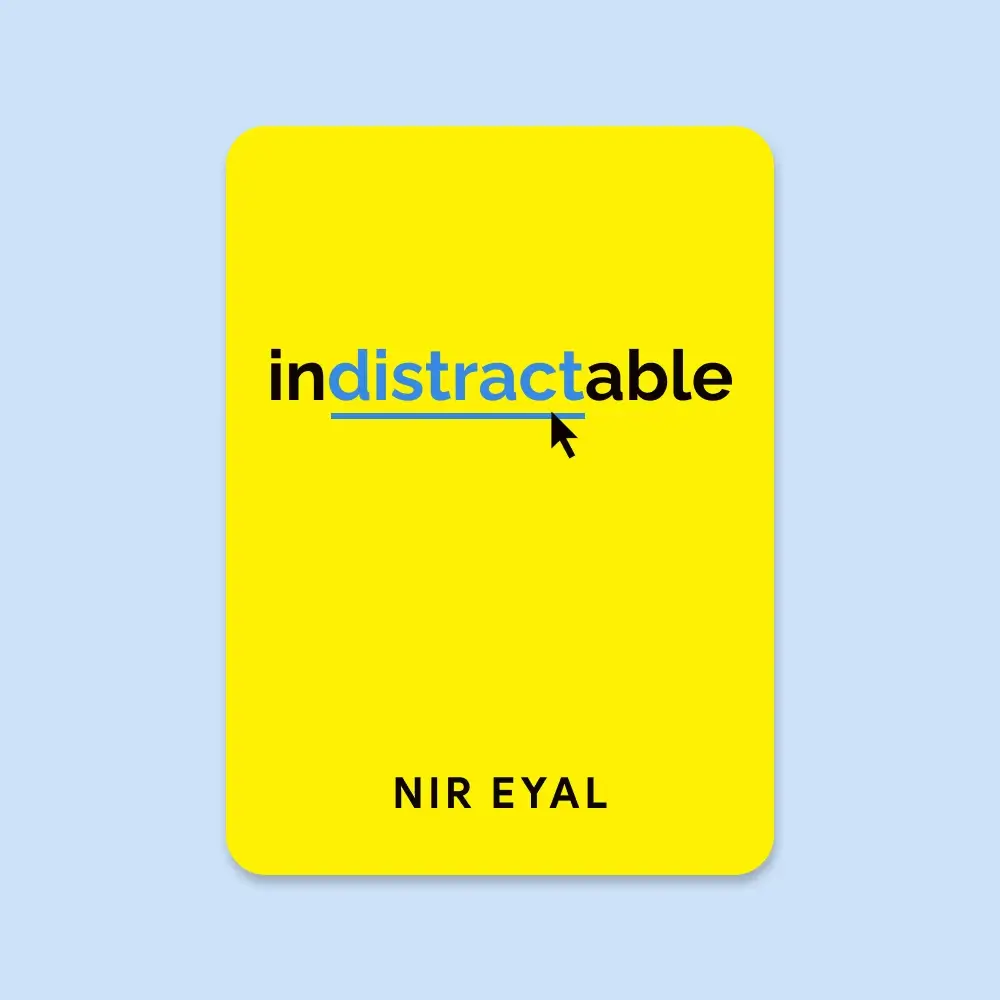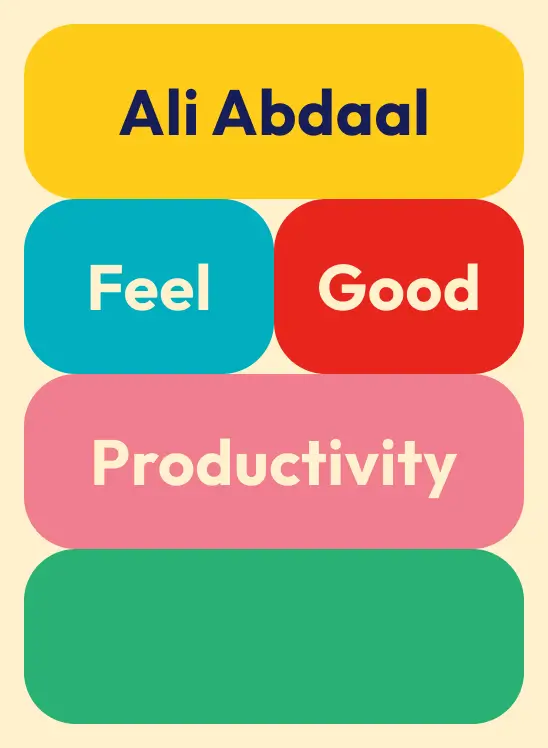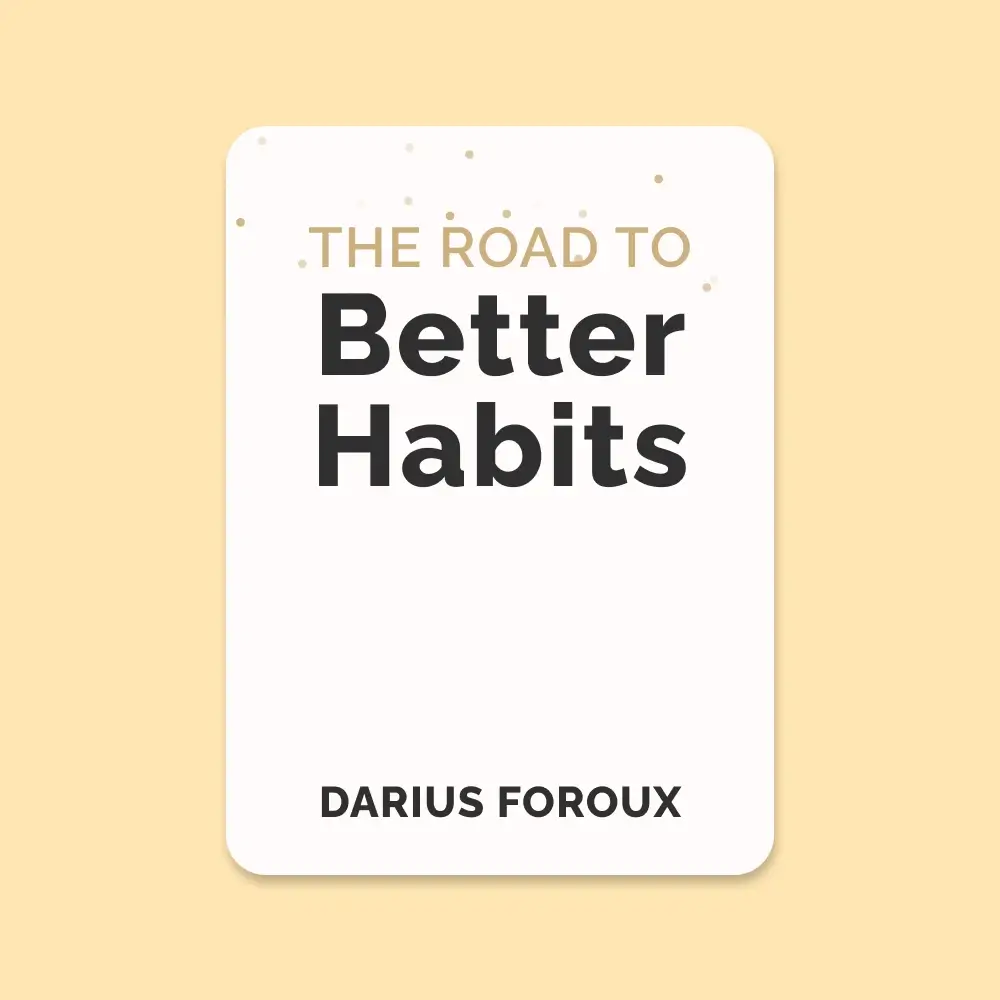
Indistractable
🎯 Distraction Is Pain Management −
- Distraction stems from the discomfort we seek to escape.
- Managing discomfort is key to staying focused.
🔍 Understand Internal Triggers −
- All motivation seeks to escape discomfort.
- Identify root causes instead of blaming external distractions.
🧘♂️ Techniques for Handling Discomfort −
- Look for triggers, write them down, explore sensations, beware liminal moments.
- Use the “ten-minute rule” to delay acting on urges.
🎲 Reimagine Tasks as Play −
- Adding fun and novelty transforms dull tasks into engaging ones.
- Play holds attention even without pleasure.
💬 Self-Compassion Over Willpower −
- Talk to yourself kindly during setbacks.
- Self-compassion improves resilience more than brute willpower.
📅 Plan Your Time −
- Distractions only exist when you lack a clear schedule.
- Fill your calendar with values-based activities.
🏡 Schedule Yourself First −
- Prioritize self-care, relationships, and meaningful work.
- Input (time invested) matters more than uncertain outcomes.
📢 Handle External Triggers −
- Ask: Is this trigger serving me, or am I serving it?
- Signal when you don’t want interruptions; defend your focus.
📧 Tame Email and Group Chat −
- Batch process messages.
- Label emails and reply at scheduled times to avoid constant distractions.
🧹 Clear Digital Clutter −
- Clean your physical and digital spaces to maintain focus.
- Remove visual distractions like unnecessary tabs or notifications.
🔗 Precommitments Prevent Distractions − Use effort pacts and price pacts to lock yourself into traction behaviors.
🧠 Identity Shapes Behavior −
- Align your identity with being indistractable.
- Behaviors shape beliefs, not just the other way around.
🏢 Culture, Not Tech, Causes Workplace Distraction −
- Psychological safety and trust at work are key to deep focus.
- Bad culture, not devices, is the real enemy.
👶 Teaching Kids to Be Indistractable −
- Meet children’s psychological needs: autonomy, competence, relatedness.
- Teach them to set limits and manage device distractions themselves.
👨👩👧👦 Parenting for Focus −
- Let kids fail and learn time management.
- Ensure screens are off during sleep times.
👥 Distraction Harms Social Bonds −
- Use social norms to discourage device usage during interactions.
- Be fully present to strengthen relationships.
🔒 Final Message − Distraction is inevitable; being indistractable is a lifelong skill to practice by mastering internal triggers, managing external ones, making time for traction, and building a supportive environment.
-
Distractions will always exist; managing them is our responsibility.
-
Being indistractable means striving to do what you say you will do.
-
Even when we think we’re seeking pleasure, we’re actually driven by the desire to free ourselves from the pain of wanting.
-
Simply put, the drive to relieve discomfort is the root cause of all our behavior, while everything else is a proximate cause.
-
Without understanding and tackling root causes, we’re stuck being helpless victims in a tragedy of our own creation.
-
Unless we deal with the root causes of our distraction, we’ll continue to find ways to distract ourselves. Distraction, it turns out, isn’t about the distraction itself; rather, it’s about how we respond to it.
-
Most people don’t want to acknowledge the uncomfortable truth that distraction is always an unhealthy escape from reality. How we deal with uncomfortable internal triggers determines whether we pursue healthful acts of traction or self-defeating distractions.
-
Without dealing with the discomfort driving the desire for escape, we’ll continue to resort to one distraction or another.
-
Only by understanding our pain can we begin to control it and find better ways to deal with negative urges.
-
Understand the root cause of distraction. Distraction is about more than your devices. Separate proximate causes from the root cause.
-
All motivation is a desire to escape discomfort. If a behavior was previously effective at providing relief, we’re likely to continue using it as a tool to escape discomfort.
-
Anything that stops discomfort is potentially addictive, but that doesn’t make it irresistible. If you know the drivers of your behavior, you can take steps to manage them.
-
As is the case with all human behavior, distraction is just another way our brains attempt to deal with pain. If we accept this fact, it makes sense that the only way to handle distraction is by learning to handle discomfort.
-
If distraction costs us time, then time management is pain management.
-
Hedonic adaptation, the tendency to quickly return to a baseline level of satisfaction, no matter what happens to us in life, is Mother Nature’s bait and switch. All sorts of life events we think would make us happier actually don’t, or at least they don’t for long.
-
Dissatisfaction and discomfort dominate our brain’s default state, but we can use them to motivate us instead of defeat us.
-
It is our dissatisfaction that propels us to do everything we do, including to hunt, seek, create, and adapt. Even selfless acts, like helping someone, are motivated by our need to escape feelings of guilt and injustice.
-
If we want to master distraction, we must learn to deal with discomfort.
-
Without techniques for disarming temptation, mental abstinence can backfire. Resisting an urge can trigger rumination and make the desire grow stronger.
-
We can manage distractions that originate from within by changing how we think about them. We can reimagine the trigger, the task, and our temperament.
-
Rather than trying to fight the urge, we need new methods to handle intrusive thoughts. The following four steps help us do just that:
-
Step 1: Look for the discomfort that precedes the distraction, focusing in on the internal trigger
-
Step 2: Write Down the Trigger
-
Step 3: Explore Your Sensations
-
Step 4: Beware of Liminal Moments
-
-
One of Bricker’s favorite techniques is the “leaves on a stream”method. When feeling the uncomfortable internal trigger to do something you’d rather not, “imagine you are seated beside a gently flowing stream,”he says. “Then imagine there are leaves floating down that stream. Place each thought in your mind on each leaf. It could be a memory, a word, a worry, an image. And let each of those leaves float down that stream, swirling away, as you sit and just watch.”
-
The “ten-minute rule.”If I find myself wanting to check my phone as a pacification device when I can’t think of anything better to do, I tell myself it’s fine to give in, but not right now. I have to wait just ten minutes. This technique is effective at helping me deal with all sorts of potential distractions, like googling something rather than writing, eating something unhealthy when I’m bored, or watching another episode on Netflix when I’m “too tired to go to bed.”
-
When an urge takes hold, noticing the sensations and riding them like a wave—neither pushing them away nor acting on them—helps us cope until the feelings subside.
-
By reimagining an uncomfortable internal trigger, we can disarm it.
-
Fun is looking for the variability in something other people don’t notice. It’s breaking through the boredom and monotony to discover its hidden beauty.
-
We can master internal triggers by reimagining an otherwise dreary task. Fun and play can be used as tools to keep us focused.
-
Play doesn’t have to be pleasurable. It just has to hold our attention.
-
Deliberateness and novelty can be added to any task to make it fun.
-
Labeling yourself as having poor self-control actually leads to less self-control. Rather than telling ourselves we failed because we’re somehow deficient, we should offer self-compassion by speaking to ourselves with kindness when we experience setbacks.
-
Self-compassion makes people more resilient to letdowns by breaking the vicious cycle of stress that often accompanies failure.
-
We can reimagine the task we’re trying to accomplish by looking for the fun in it and focusing on it more intensely.
-
We don’t run out of willpower. Believing we do makes us less likely to accomplish our goals by providing a rationale to quit when we could otherwise persist.
-
What we say to ourselves matters. Labeling yourself as having poor self-control is self-defeating.
-
Practice self-compassion. Talk to yourself the way you’d talk to a friend. People who are more self-compassionate are more resilient.
-
If we don’t plan our days, someone else will.
-
You can’t call something a distraction unless you know what it’s distracting you from.
-
We actually perform better under constraints. This is because limitations give us a structure, while a blank schedule and a mile-long to-do list torments us with too many choices.
-
The goal is to eliminate all white space on your calendar so you’re left with a template for how you intend to spend your time each day.
-
Exercise, sleep, healthy meals, and time spent reading or listening to an audiobook are all ways to invest in ourselves.
-
When it comes to our time, we should stop worrying about outcomes we can’t control and instead focus on the inputs we can. The positive results of the time we spend doing something is a hope, not a certainty.
-
The one thing we control is the time we put into a task.
-
Schedule time for yourself first. You are at the center of the three life domains. Without allocating time for yourself, the other two domains suffer.
-
Show up when you say you will. You can’t always control what you get out of time you spend, but you can control how much time you put into a task.
-
Input is much more certain than outcome. When it comes to living the life you want, making sure you allocate time to living your values is the only thing you should focus on.
-
The people we love most should not be content getting whatever time is left over. Everyone benefits when we hold time on our schedule to live up to our values and do our share.
-
The time we spend with our friends isn’t just pleasurable—it’s an investment in our future health and well-being.
-
If someone is important to you, make regular time for them on your calendar.
-
Syncing your schedule with stakeholders at work is critical for making time for traction in your day. Without visibility into how you spend your time, colleagues and managers are more likely to distract you with superfluous tasks.
-
Motivation is “the energy for action,”
-
Today, much of our struggle with distraction is a struggle with external triggers.
-
The more we respond to external triggers, the more we train our brain in a never-ending stimulus–response loop. We condition ourselves to respond instantly. Soon, it feels impossible to do what we’ve planned because we’re constantly reacting to external triggers instead of attending to what’s in front of us.
-
How, then, can we separate the good external triggers from the bad? The secret lies in the answer to a critical question: Is this trigger serving me, or am I serving it?
-
If the trigger helps us do the thing we planned to do in our schedule, it’s helping us gain traction. If it leads to distraction, then it isn’t serving us.
-
External triggers often lead to distraction. Cues in our environment like the pings, dings, and rings from devices, as well as interruptions from other people, frequently take us off track.
-
The way to reduce unwanted external triggers from other people is to display a clear signal that you do not want to be interrupted. Doing so will help colleagues or family members pause and assess their own behaviors before they break your concentration.
-
Interruptions lead to mistakes. You can’t do your best work if you’re frequently distracted.
-
Defend your focus. Signal when you do not want to be interrupted. Use a screen sign or some other clear cue to let people know you are indistractable.
-
Office workers took an average of sixty-four seconds after checking email to reorient themselves and get back to work. Given the hundreds of times per day we check our devices, those minutes can add up.
-
Most emails we send and receive are not urgent. Yet our brain’s weakness for variable rewards makes us treat every message, regardless of form, as if it’s time sensitive. That tendency conditions us to check constantly, return replies, and bark out whatever requests come to mind instantaneously. These are all mistakes.
-
You’d be amazed how many things become irrelevant when you give them a little time to breathe.
-
There’s mounting evidence that processing your email in batches is much more efficient and less stress inducing than checking it throughout the day. This is because our brains take time to switch between tasks, so it’s better to focus on answering emails all at once.
-
Checking email isn’t so much the problem; it’s the habitual rechecking that gets us into trouble.
-
Reduce the number of messages received. Schedule office hours, delay when messages are sent, and reduce time-wasting messages from reaching your inbox.
-
Spend less time on each message. Label emails by when each message needs a response. Reply to emails during a scheduled time on your calendar.
-
We should use group chat in the same way we use other synchronous communication channels.
-
If we are going to spend our time in a meeting, we must make sure that we are present, both in body and mind.
-
The good news is, being dependent is not the same thing as being addicted.
-
Removing unnecessary external triggers from our line of sight declutters our workspace and frees the mind to concentrate on what’s really important.
-
Desktop clutter takes a heavy psychological toll on your attention. Clearing away external triggers in your digital workspace can help you stay focused.
-
Although we can only receive information from one visual or auditory source at a time, we are perfectly capable of processing multichannel inputs. Scientists call this “cross-modal attention,” and it allows our brains to place certain mental processes on autopilot while we think about other things.
-
As long as we’re not required to concentrate too much on any one channel, we’re able to do more than one thing at a time.
-
Online articles are full of potentially distracting external triggers. Open tabs can pull us off course and tend to suck us down a time-wasting content vortex.
-
Precommitments can reduce the likelihood of distraction. They help us stick with decisions we’ve made in advance.
-
An effort pact prevents distraction by making unwanted behaviors more difficult to do.
-
If we are bound by a pact for too long, we begin to associate it with punishment, which can spawn counterproductive effects, such as resentment of the task or goal.
-
A price pact adds a cost to getting distracted. It has been shown to be a highly effective motivator.
-
Price pacts are most effective when you can remove the external triggers that lead to distraction.
-
Price pacts work best when the distraction is temporary.
-
The way we think of ourselves also has a profound impact on how we deal with distractions and unintended behaviors.
-
By aligning our behaviors to our identity, we make choices based on who we believe we are.
-
Though conventional wisdom says our beliefs shape our behaviors, the opposite is also true.
-
Identity greatly influences our behavior. People tend to align their actions with how they see themselves.
-
Technology is not the root cause of distraction at work. The problem goes much deeper.
-
Companies consistently confuse the disease of bad culture with symptoms like tech overuse and high employee turnover.
-
Only when companies give employees a psychologically safe place to air concerns and solve problems together can they solve some of their biggest workplace challenges. Creating an environment where employees can do their best without distraction puts the quality of the organization’s culture to the test.
-
Stop deflecting blame. When kids don’t act the way parents want, it’s natural to look for answers that help parents divert responsibility.
-
Tech isn’t evil. Used in the right way and in the right amounts, kids’ tech use can be beneficial, while too much (or too little) can have slightly harmful effects.
-
Teach kids to be indistractable. Teaching children how to manage distraction will benefit them throughout their lives.
-
If a child isn’t doing well in school and doesn’t get the necessary individualized support, they start to believe that achieving competence is impossible, so they stop trying. In the absence of competency in the classroom, kids turn to other outlets to experience the feeling of growth and development. Companies making games, apps, and other potential distractions are happy to fill that void by selling ready-made solutions for the “psychological nutrients”kids lack.
-
“We call this the ‘need density hypothesis,’”says Ryan. “The more you’re not getting needs satisfied in life, reciprocally, the more you’re going to get them satisfied in virtual realities.”
-
To understand how to help kids manage distraction, we need to start by understanding the source of the problem.
-
According to a widely accepted theory of human motivation, all people need three things to thrive: a sense of autonomy, competence, and relatedness.
-
Parents and guardians can take steps to help kids find balance between their online and offline worlds by providing more offline opportunities to find autonomy, competence, and relatedness.
-
When our kids’ psychological needs are not met in the real world, they go looking for satisfaction—often in virtual environments.
-
Empowering children with the autonomy to control their own time is a tremendous gift. Even if they fail from time to time, failure is part of the learning process.
-
With so many potential distractions in kids’lives, teaching them how to make time for traction is critical.
-
It’s OK to let your kids fail. Failure is how we learn. Show kids how to adjust their schedules to make time to live up to their values.
-
As parents, we often forget that a kid wanting something “really, really badly” is not a good enough reason.
-
As kids get older, a good test of whether they are ready for a particular device is their ability to understand and use the built-in settings for turning off external triggers.
-
Making sure kids get enough sleep is “the one issue with the most incontrovertible evidence.” Kamenetz strongly advises that “screens and sleep don’t mix” and implores parents to keep all digital devices out of kids’ rooms at nighttime and to shut down screens at least an hour before bedtime.
-
Any disturbance at the wrong time is a distraction.
-
A good measure of a child’s readiness is the ability to manage distraction by using the settings on the device to turn off external triggers.
-
It’s only when kids can monitor their own behavior that they learn the skills they need to be indistractable—even when their parents aren’t around.
-
Don’t underestimate your child’s ability to precommit and follow through. Even young children can learn to use precommitments as long as they set the rules and know how to use a timer or some other binding system.
-
Modern technologies like smartphones, tablets, and laptops aren’t the only sources of distraction in social situations.
-
Distraction in social situations can keep us from being fully present with important people in our lives. Interruptions degrade our ability to form close social bonds.
-
Block the spread of unhealthy behaviors. “Social antibodies” are ways groups protect themselves from harmful behaviors by making them taboo.
-
Develop new social norms. We can tackle distraction among friends the same way we beat social smoking, by making it unacceptable to use devices in social situations. Prepare a few tactful phrases—like asking, “Is everything OK?”—to discourage phone usage among friends.
-
Distractions can take a toll on even our most intimate relationships; the cost of being able to connect with anyone in the world is that we might not be fully present with the person physically next to us.



































